Family : Siganidae

Text © Giuseppe Mazza

English translation by Mario Beltramini
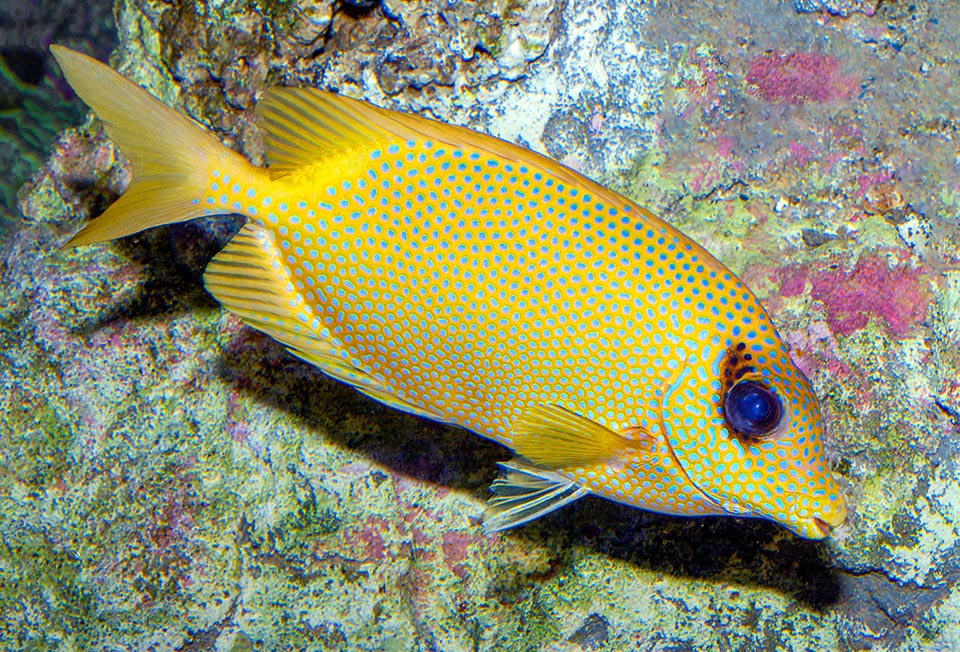
Siganus corallinus is a rabbitfish, so called for the head profile with prominent lips and the tiny interlocking teeth, built to sever algae and aquatic plants © Giuseppe Mazza
Siganus corallinus (Valenciennes, 1835) belongs to the class of the Actinopterygii, the ray-finned fishes, to the order of the Perciformes and to the family of Siganidae, having only one genus, Siganus, and about thirty species.
These are the so-called rabbitfishes, due to the profile of their head with protruding lips and small interlocking teeth, made to sever the algae and the aquatic plants in the seagrass meadows. These are marine fishes are mainly herbivorous that at times venture for short distances in the brackish waters of the river’s mouths.
The etymology of the genus Siganus gets its origin from the Arabic term “sidjan”, assigned by Forsskål in 1775 to the Siganus rivulatus.
The specific name of the genus corallinus, of the corals in Latin, refers to the madreporic environment where it lives.
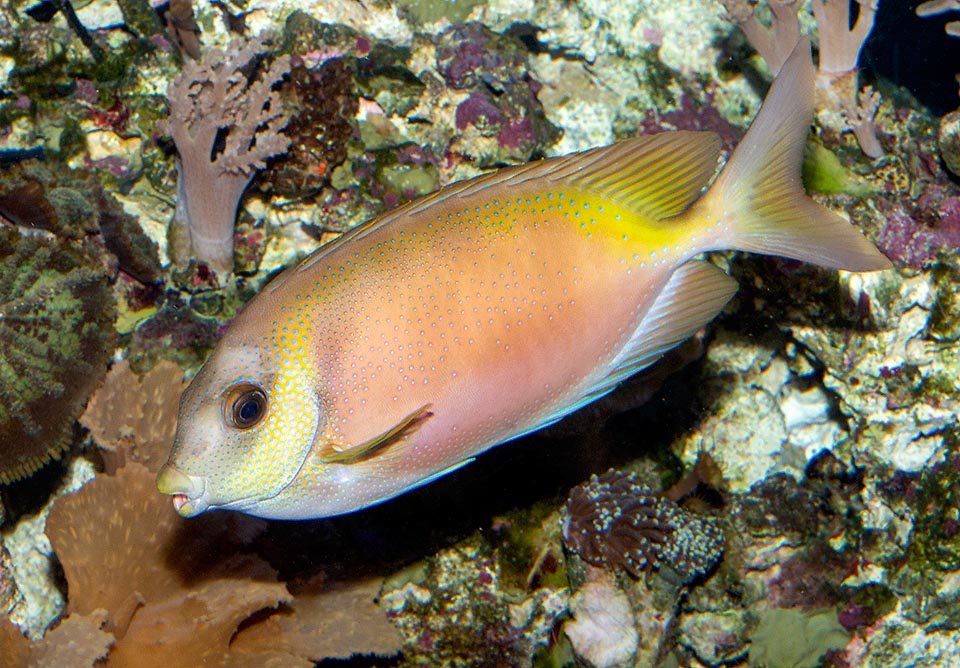
The various populations have often, geographically, very different liveries, so much that some talk of new species or subspecies © Giuseppe Mazza
Zoogeography
The Siganus corallinus has a very vast diffusion in the Indian Ocean and in western Pacific. Indicatively, starting from the Seychelles, we find it in the Maldives, along the Indian coasts and then, eastwards, in the Andaman and Nicobar Islands, Thailand, Malaysia, Indonesia, Australia, Papua New Guinea, Micronesia, Solomon Islands, Vanuatu and New Caledonia that marks the southern limit of the species. Northwards, after the Philippines, it reaches the southern Japanese coast.
Ecology-Habitat
It is a diurnal fish mainly present in shallow waters, from 3 to 25 m of depth, in lagoons full of corals, often sheltered by madreporic formations of the genus Acropora that grant secure hideouts among their tables and their prickly ramifications. Sites where to disappear quickly at the sight of the predators and where to spend peaceful nights.
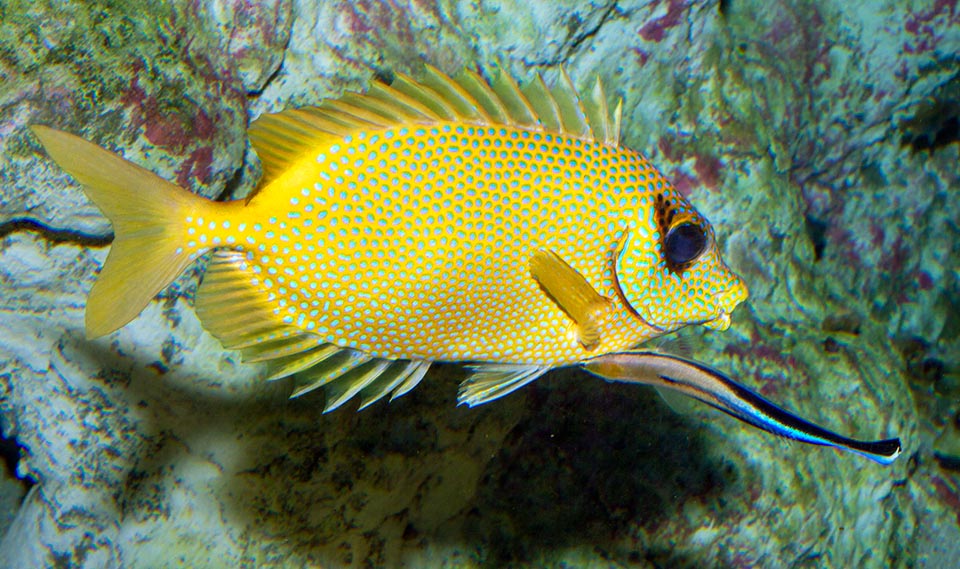
In this stretched fins specimen, cleaned by a Labroides dimidiatus, are well visible the spiny rays linked to the venomous glands © Giuseppe Mazza
The juveniles prefer the prairies of phanerogams where they move in small schools, often mixed with those of the Scaridae, the so-called parrotfishes, whilst the adults tend to isolate themselves in pairs among the madrepores and to graze on benthic algae.
Morphophysiology
The Siganus corallinus can reach a length of 35 cm, even if the fished specimens are of about 20 cm. The body is oval, very flattened on the sides. The dorsal fin has 13 spiny rays and 10 soft, the anal, 7 spiny and 9 unarmed rays. The big pectoral fins have 16-17 soft rays and the oddness is offered by the pelvic ones with 2 spiny rays spaced by 3 unarmed. All spiny rays have on the sides, two cavities with glands producing a poisonous mucus, luckily thermolabile, that causes painful wounds. The caudal fin is truncated in the young and forked in the adults.
The livery, characteristic to the species, is yellow with blue ocelli. More intense spots on the head where they merge in small traits and become almost black around the eye whilst the yellow colour darkens creating a dark zone, more or less triangular, that masks its outline.
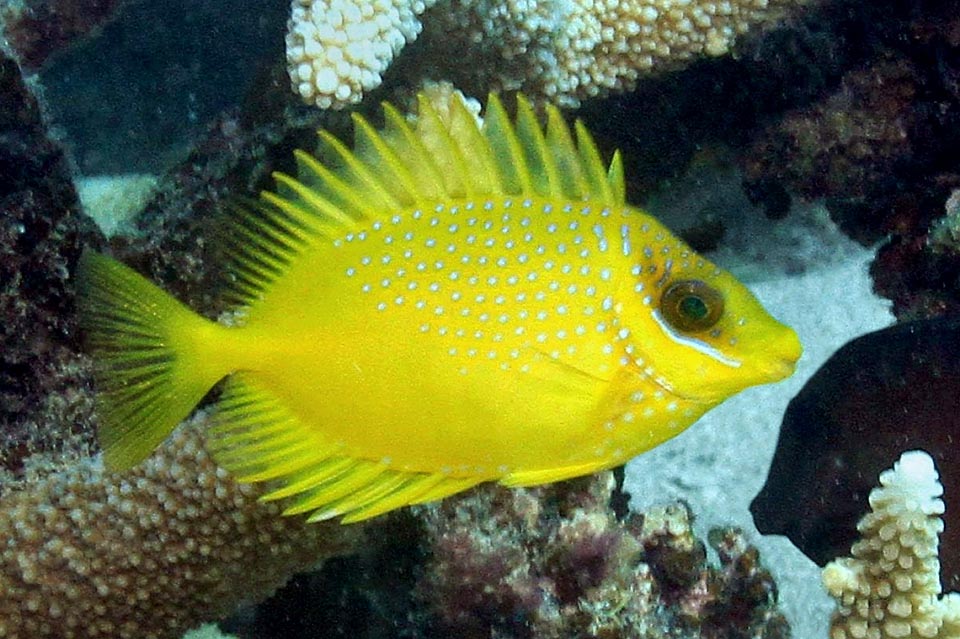
Juveniles may show vertical blue stripes on the sides that will form, breaking, the typical dotting of the species © Graham Edgar, Reef Life Survey
Remarkable variants of colour do exist depending on the zones, so much to induce some ichthyologists to talk, on geographical basis, of 2 or 3 possible species or subspecies, presently considered as synonyms. In any case, during the night, the colours fade replaced by a brown camouflaging pyjamas which is less conspicuous.
Ethology – Reproductive Biology
The Siganus corallinus, nourishes for the 60% of vegetables, phytoplankton, algae and aquatic plants, and for the rest, of zooplankton and of some benthic invertebrates.
The reproduction, seemingly related to the water temperature and to the lunar cycles, occurs by the sunset. The larvae are planktonic as well as the post-larval stage lasting long enough with transparent pelagic forms without scales. They nourish of the plankton in relatively deep waters, to settle then, growing, on the coastal bottoms and assuming, while colouring, the juvenile form.
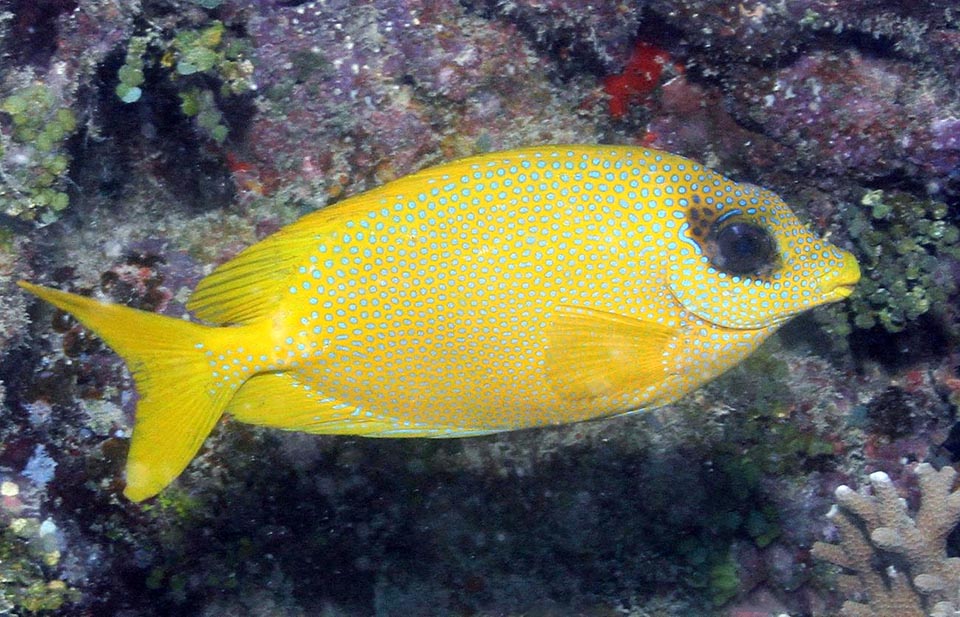
Siganus corallinus can be 35 cm long and at times appears in local fish markets, but the flesh may aver poisonous or hallucinogenic © Graham Edgar, Reef Life Survey
When they reach the 5 cm, they are yellow small fishes with eventual vertical blue stripes on both sides that will form, when breaking, the dotting typical of the species.
The Siganus corallinus is locally fished for feeding purposes, but its flesh may be poisonous or hallucinogenic.
The resilience of the species is good, with a possible doubling of the populations decimated by the events in less than 15 months. The vulnerability index, moderate, is nowadays marking, in 2020, only 27 on a scale of 100.
Synonyms
Amphacanthus corallinus Valenciennes, 1835; Teuthis corallina (Valenciennes, 1835); Teuthis corallinus (Valenciennes, 1835); Amphacanthus tetrazona Bleeker, 1855; Siganus tetrazona (Bleeker, 1855); Siganus tetrazonus (Bleeker, 1855); Teuthis tetrazona (Bleeker, 1855); Teuthis studeri Peters, 1877; Teuthis teuthopsis De Vis, 1884.
→ For general information about FISH please click here.
→ For general information about BONY FISH please click here
→ For general information about CARTILAGINOUS FISH please click here.
→ To appreciate the BIODIVERSITY of BONY FISH please click here.
→ To appreciate the BIODIVERSITY of CARTILAGINOUS FISH please click here.
